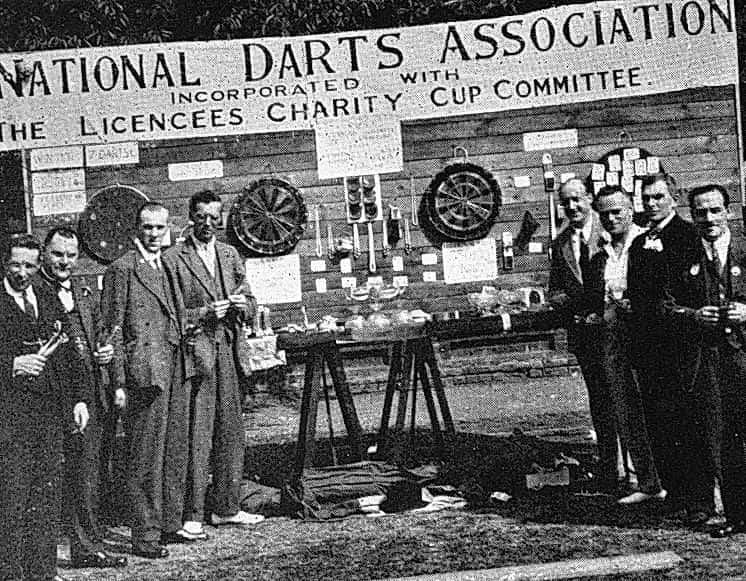The FSGT darts on traditional targets were created in the Bas-Rhin in 1989. Since then, the activity has continued to develop and become more structured.
Traditional dart of war is above all an activity requiring good skill… but it is also a game designed so that everyone can quickly acquire sufficient precision to have fun.
Traditional darts player
Traditional darts take up very little space and can be played indoors or outdoors, and no special equipment is required!
It is also an activity that has no language, social or cultural barriers. It can be played individually, in teams, and as a family, with young people playing with adults and men with women.
Traditional dart of war is an amazing and spectacular activity, because of the rules of the game, the winner is always uncertain, no matter how far apart the opponents are!

The origin of darts
Several hundred years ago, a rather cold and thirsty archer decided to develop a more pleasant method of training for the winter months. He put his bow aside, cut up his arrows, and took refuge in the warmth and comfort of the local tavern, where he could now perfect his shooting by throwing his shortened arrows at a wooden log hanging on the wall.
Thus was born the game of darts, which over the centuries became an important part of British tradition. In fact, Britain is the most populous nation in the world with 6 million players, and it is hard to find an Englishman over the age of twelve who has not at least once thrown a dart.
But dart of war is not limited to the UK. Over the past 25 years, the sport has spread throughout the world and is becoming truly international.
Dart of war: information and equipment
The target is divided into 21 sectors:
Sectors 1 to 20, which have an angle of 18 degrees (360 degrees/20). The bubble, in the centre of the target.
These sectors are themselves divided into different parts of varying size:
- Singles (a hit in a single count once)
- Doubles (one hit in a double count twice)
- Triples (one hit in a triple count three times)
- The outer bubble (a hit in the outer bubble counts, depending on the game, as one hit or 25 or 50 points)
- The inner bubble (a hit in the inner bubble counts, depending on the game, as one or two hits or 50 points)
Different colours are used to mark differences in value:
- Singles are usually black or white
- Doubles and triples are usually green or red
- The outer bubble is usually red
- The inner bubble is usually black
Rules of the darts game
The official rules
As with a card game, it is possible to play several different games. This avoids a certain weariness that could set in and allows different players to compete on often amusing variants. However, there are official rules adopted in all tournaments.
The 501 double out
Each player starts with a capital of 501 points. The player then throws a volley of three darts (or less), adds up the score of the darts, and subtracts the result from his or her capital to arrive first at exactly zero (without going over). To reach zero, you must throw your last dart of the round into a “double” sector or into the double centre (the term “double out” comes from the name of the rule). If you go over zero, the whole round is cancelled.
A game of 501 is completed in at least 3 rounds (9 darts in total) and is then called a nine-darter.
The 301 double out
The 301 rule is the same as the 501 rule with the difference that players start the game with a score of 301 instead of 501.
In general, darts tournaments are played as 501 double out, but there are other variations, which can be played for fun with friends, or for practice.
The clock
This is a training exercise. The aim of the game is to put a dart in each segment of the target in the right order. You start by aiming at 1, when you have succeeded, you move on to 2 and so on until you reach 20 and then the bull (25 point game).
The Shanghai
Another training exercise, in the style of the clock. The aim is to hit singles, doubles, and triples of the same value (a Shanghai) in the same round. You start with a one and move to a two in the next round, whether you succeed or not. The winner is the one who makes a Shanghai. The game is limited to 7 darts.
Cricket
This is a friendlier game to play with friends. The aim is to score three 15s, three 16s, three 17s, three 18s, three 19s, three 20s, and three bulls. You write down the score as you go along on a piece of paper.
Cut Throat Cricket
This is a variation of cricket. The difference is that when a player scores in a value, it is awarded to all his opponents who have not closed that value. The winner is the first player to close all and have the lowest score (or equal to that of an opponent). This variant is especially interesting when the number of players is 3 or more.
The count up
The principle is very simple: you set a number of rounds (for example 10). The aim is to score as many points as possible in this number of rounds.
Football
For two players, the aim of this game is to score a set number of goals. Each player has to make at least a half-bull to be an attacker and then a double to score. If he succeeds in being an attacker without making a double afterward, he remains an attacker as long as the opponent does not get the ball back (succeeds in making a half-bull).
